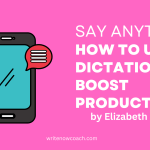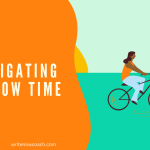NaNoWriMo: Write More, Work Less
Welcome writers! A few months ago, I was searching online for software and apps that writers could use to increase their efficiency. I happened upon a wonderful post by Jonathan Milligan at Blogging Your Passion and quoted him in one of my blog posts. Jonathan was kind enough to review my new book Write-A-Thon at his blog. Today, I am delighted to welcome him to the Write Now! Coach blog to talk about how you can write more and work less! Enjoy!
 Write More, Work Less By Jonathan Milligan
Write More, Work Less By Jonathan Milligan
Wouldn’t it be great if you could learn to write more and work less? Can you write a book in 26 days and still have time to play? Can you start a successful blog while having a full-time job? It really is not all that impossible. I’ve had a passion for writing since I was in high school. It wasn’t until I was 33 years of age that I finally gave into my passion.
The Law of the Lid. Early in my writing career, I placed certain limitations on my writing output. I mistakenly thought that I was only able to produce a certain amount of words, articles, and blog posts per day. I placed a lid on my productivity. It reminds me of the story about training fleas. Place fleas in a jar with a lid and they will only learn to jump so high. Remove the lid and they still jump at the same height even though they are capable of doing more. When it comes to writing, you have more potential than you often realize.
My 90 Day Blogging Challenge. About a year ago, I decided to set a goal that both excited me and scared me at the same time. I wanted to write 300,000 words in 90 days. Most of my writing was going to be published on several different blogs that I operate. I know, it sounds completely crazy, but I wanted to challenge my “lid.” I figured out that I had to write 3,333 words a day to get there.
I kept track of my daily output so I knew at anytime if I was behind or ahead of my pace. At the end of 90 days, I had written over 351,469 words. I did it one day at a time.
Did it come easy for me? No, it was one of the most challenging things I had ever done. However, along the way I learned some important principles that I want to share with you.
Tips for Writing More and Working Less
*Have Focus Writing Sessions. It is absolutely important that you set aside time along with a deadline to write. I often work in 90 minute blocks with a 30 minute break. Decide ahead of time how many writing sessions you are able to do in a week’s time. I always map out how many writing sessions I can do in the coming week on Sunday nights.
*Manage Your Distractions. When you set lofty writing goals, managing distractions becomes magnified in your life. You need to learn to handle both internal and external distractions. To be honest, internal distractions are my biggest nemesis. My mind is racing all over the place even when I am fully engaged in writing. I have already thought of 5 or 6 things I need to do since I started writing this blog post. I now have a 3×5 card beside me during my focus writing sessions. Anything that comes to mind gets written down on that card. We often stop what we are doing to do something else because we simply do not want to forget about it. My thought is that anything can wait 90 minutes.
External distractions are a bit different. Since I work from home external distractions can be a challenge. If my wife comes to me in the middle of a focus session, I just let herknow how much time I have until my next break and then I write down the topic of discussion on my 3×5 card.
*Learn the Art of Taking “Real” Breaks. You cannot burn the candle at both ends and be productive. Working more does not equal getting more things done. Read that statement again and let it sink in. This was a hard yet important lesson for me to learn. I mistakenly thought that the more hours I sat in front of my computer, the more I was getting done. What I discovered is that when my “blade” was dull it took me twice as long to get things done.
I also had to learn what a “real” break was for me. A “real” break for me is just about anything that does not include sitting in front of the computer. I used to use my breaks to check my email, managing blog comments, read blog posts, etc. What I found out was that those things were not a “mental break” for me. Here is a list of things I like to do that constitute as a “real” break: take a walk outside, play with the dog, go to the park with my kids, exercise, sit and talk with my wife, read a book outside, and take a nap.
If I told you that I generally do all of the above every day, you would think that I was lazy and good for nothing. I am here to tell you that I do all of the above and get more done than ever before. The items that I mentioned above “sharpen the saw” for me. When I sit down after a break, I am ready to go. Writing flows much easier for me. I am not as restless and I am fully engaged. It works much better for me than just sitting in front of the computer all day.
Whether you are writing part-time or full-time, you can use the principles I shared above to write more and work less. Do not fall into the trap that more is always better. You can work less and write more. Give it a try.
About the Author. Jonathan Milligan has been blogging since 2009 and is still in awe that the Creator of the Universe desires to have a relationship with him. His passions include spending time with his kids, reading, March Madness, surprise get-a-way trips with his wife, and watching funny YouTube videos. Visit him online at Blogging Your Passion.















These are awesome tips, thank you!
Thanks!